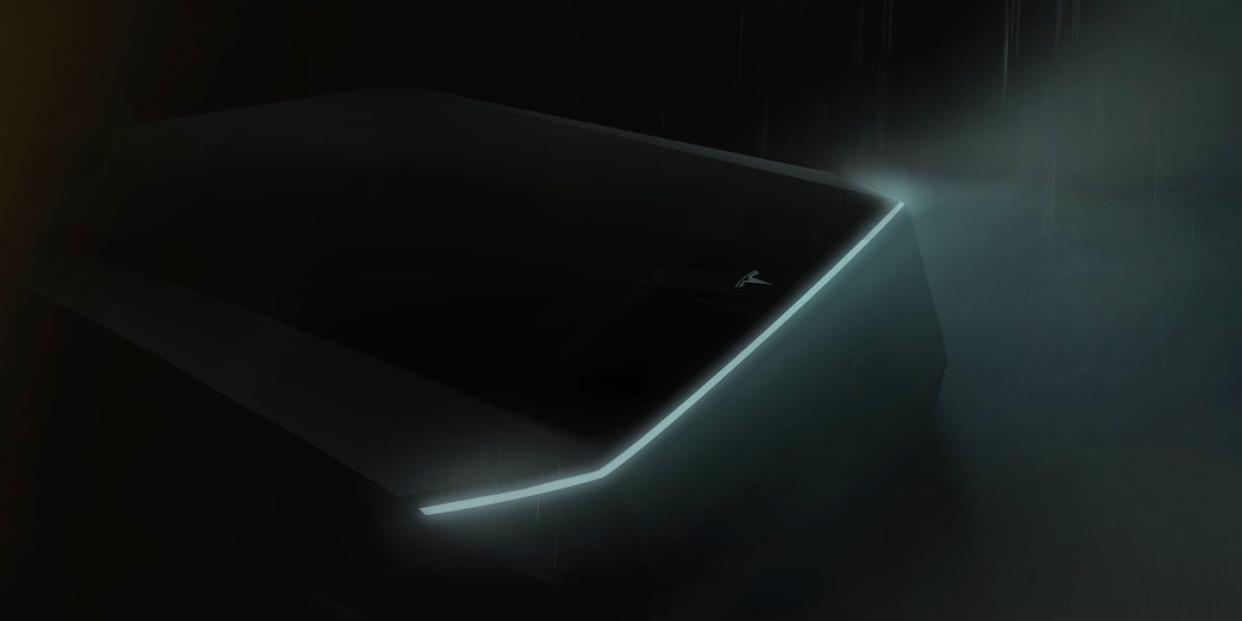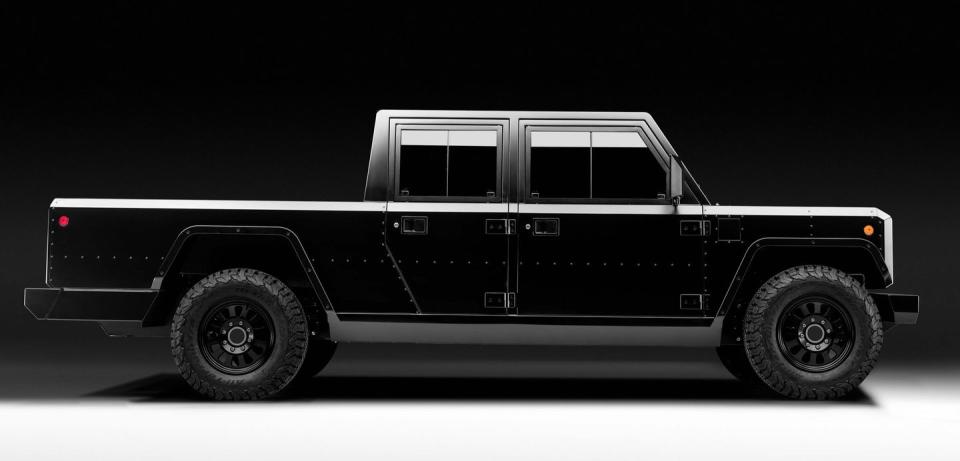Everything We Know About Tesla’s Mysterious New Pickup Truck

This post has been updated to preface Tesla's announcement of the "Cybertruck" on November 21, 2019, at 8 p.m. The livestream will likely be live on Tesla's website here. We'll update with information as it becomes available.
Original post: On November 21, the last day of the Los Angeles Auto Show, Tesla will unveil its long-anticipated pickup truck. CEO Elon Musk announced the event on Twitter last week, indicating that it will take place near his SpaceX factory in Los Angeles.
Cybertruck unveil on Nov 21 in LA near SpaceX rocket factory
— Elon Musk (@elonmusk) November 6, 2019
Though not much has been revealed about the truck’s overall look, a mysterious teaser Musk dropped in March suggests a potentially radical design—though the image can be interpreted as either the hood or a pickup bed with a sleek, matching tonneau cover on board.
About a minute in, we flashed a teaser pic of Tesla cyberpunk truck pic.twitter.com/hLsGsdyuGA
— Elon Musk (@elonmusk) March 16, 2019
Musk also revived hints that the vehicle would be inspired, in some capacity, by the film Blade Runner, and exchanges with his followers on Twitter, who joked about needing to wear cyberpunk costumes to the reveal, were met approvingly by the CEO. Still more tweets earlier this year claimed the truck would be “something quite unique, unlike anything.”
Not convinced that he’s committed to the effort? Consider a recent corporate earnings call, in which Musk called the “Cybertruck” the company’s “best product ever,” or the Recode interview he did late last year, in which he gushed about his enthusiasm for the project: “It’s gonna be awesome, it’s gonna be amazing. This will be heart-stopping. It stops my heart. It’s like, oh, it’s great.”
Breathless gushing aside, on a purely practical level, the arrival of the Cybertruck—alternatively called the Model B—will round out the company’s lineup and potentially lure a segment that has long been generally EV-resistant. While there’s no guarantee that Musk will successfully change most of those stalwart minds, the specs that have been speculated upon are fairly compelling: a range between 400 and 500 miles, declared in 2018; power outlets for heavy-duty tools, no generator required—something sure to appeal to the more hardcore truck users; and an equally appealing price below $50,000. Presumably, that would be for the base model, at least in terms of battery size, and more powerful versions will likely go significantly higher.
It’s also reportedly going to bring automatic parallel parking, a particularly novel drop-down tailgate design, and possibly the first million-mile battery pack.
One advantage that Tesla has in this market that it hasn’t previously is lots of competition—giving it at least a glimpse into how potential customers have responded to proposed designs so far. (Not that the company has ever marched to anything but its own internal drummer.) There are at least three known pickup trucks in development at the moment, including the Rivian R1T, the Bollinger Motors B2, and a Ford F-150, all expected to hit the streets in the next two years.

What the current crop of electric pickups tend to gravitate toward is a creative embrace of the versatility of the electric powertrain, most notably in terms of space usage. The Bollinger pickup, for instance, plays with the absence of a front engine by providing a pass-through storage tunnel from front to rear, in case you want to transport, say, a telephone pole. (Though most likely a load of lumber.) Looking somewhat like a Hummer H1, it also has a custom-designed, two-speed transmission—a rarity in the EV world, with the Porsche Taycan being the only such product now on the market—that will allow it to cruise efficiently down the highway and also tackle tough terrain like steep slopes and craggy rocks that can’t all be managed in a single gear.
The Bollinger will have a 15-inch ground clearance and mostly be a niche, low-volume product oriented toward off-roading, with a 5,000-pound payload and 10 inches of wheel travel. The truck’s dual electric motors will produce 614 horsepower and 668 pound-feet of boulder-bashing torque. It will also have the largest battery pack of any EV currently on the market, at 120 kWh.

The Rivian will be able to best that, with three battery options of 105, 135, and 180 kWh—the latter of which will push it over the 400-mile range mark—and will bring its own off-road chops to the table, including 750 hp and the ability to ford water 42 inches deep. Its cool trick is its gear storage tunnel, which runs from side to side with doors on either end and a capacity of 12 cubic feet.
That truck’s greatest unknown, however, is how its four separate motors, one at each wheel, will impact its agility, given that those motors could possibly limit suspension travel or flexibility. The R1T is due to get a 1,764-pound payload capacity, a towing capacity of 11,000 pounds, and a startling 0 to 60 time of 3 seconds.
Much less is known about the Ford electric truck, though more will become clear about its powertrain when the company unveils its Mustang-inspired crossover, also next week in conjunction with the L.A. Auto Show.
In the end, there will be lots of interesting details to look for next week. The most interesting part of Tesla’s pickup truck reveal will be its powertrain strategy—two motors, four motors, battery size—how off-roadable it truly is, and how it will manage tricky conditions such as variable terrain, awkward loading conditions, and more. Then there are the clever tricks Musk likely has up his sleeve for the truck, and its evidently radical overall design. Will it draw in the pickup truck crowd, or is it designed mostly to bring the pickup appeal to those not already bought into the idea? Will it be a true utility vehicle, or just a burly looking soft-roader?
Finally, Musk’s dropping of expected towing capacity, in which he corrected a follower from 30,000 pounds to 300,000 pounds, is a cryptic claim, for sure. It’s either theoretical or real but somehow narrowly defined—as in, it can tow a train weighing 300,000 pounds.
300,000 lb towing capacity
— Elon Musk (@elonmusk) June 27, 2018
That’s something that’s fairly easily done, as noted by mechanical engineer Jason Fenske in a video posted to his Engineering Explained channel on YouTube, but it’s nevertheless a fun idea to contemplate.
Of course, so is any new Tesla product in general, so we’ll be all ears next Thursday when the big reveal comes.
You Might Also Like

